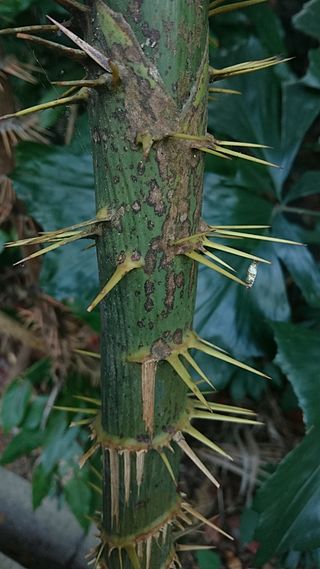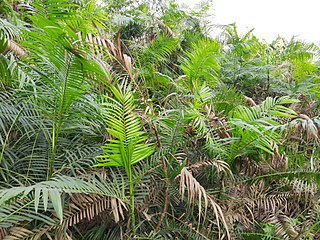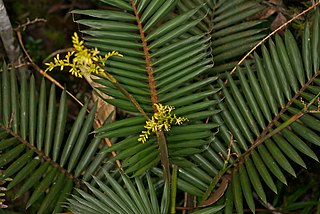
Rattan, also spelled ratan, is the name for roughly 600 species of Old World climbing palms belonging to subfamily Calamoideae. The greatest diversity of rattan palm species and genera are in the closed-canopy old-growth tropical forests of Southeast Asia, though they can also be found in other parts of tropical Asia and Africa. Most rattan palms are ecologically considered lianas due to their climbing habits, unlike other palm species. A few species also have tree-like or shrub-like habits.

Myrialepis is a monotypic genus of flowering plant in the palm family. The single species, Myrialepis paradoxa, is native to Southeast Asia. The genus name is a combination of the Greek words meaning "innumerable" and "scale", a description of the fruit, and the epithet is Latin for "paradox".

Calamus rotang, also known as common rattan, is a plant species native to India, Sri Lanka and Myanmar (Burma). It is one of the scandent (climbing) rattan palms used to make Malacca cane furniture, baskets, walking-sticks, umbrellas, tables and general wickerwork, and is found in Southwest Asia. The basal section of the plant grows vertically for 10 metres or so, after which the slender, tough stem of a few centimetres in diameter, grows horizontally for 200 metres or more. It is extremely flexible and uniform in thickness, and frequently has sheaths and petioles armed with backward-facing spines which enable it to scramble over other plants. It has pinnate, alternate leaves, 60–80 cm long, armed with two rows of spines on the upper face.

Calamus tenuis is a species of flowering plant in the family Arecaceae. It is native to India, Assam, Bangladesh, Bhutan, Cambodia, Laos, Burma, Thailand, Vietnam, Java and Sumatra.

Calamoideae is a subfamily of flowering plant in the palm family found throughout Central America, South America, Africa, India, China, Southeast Asia and Australia. It is represented by 21 genera - containing nearly a quarter of all species in the palm family - including the largest genus, Calamus, the type genus of the group. Only four are found in the New World while the rest are Old World denizens, usually found in equatorial swampland or along tropical coastlines.
Climbing palms are genera in the family Arecaceae that grow as lianas. "Initially erect, the slender stems seek out trees for support and climb up into the forest canopy by means of recurved hooks and spines growing on the stem, leaves and inflorescences. In all climbing palms the leaves are pinnate and grow along the stem instead of forming a dense crown. The stems of climbing palms, more often referred to as canes, are solid in contrast to bamboo poles which are almost always hollow." "The majority of climbing palms are also clumping palms [and sympodial], sending out new shoots from [below ground as suckers]." "About 600 species of palms in [16] genera have a climbing growth habit. Most noteworthy is the genus Calamus--the largest genus in the palm family with approximately 350 described species--source of nearly all commercial rattan."
Plectocomia pierreana is a species of liana in the Arecaceae, or palm tree, family. It is a spiny climber, with either a single stem or a cluster of stems up to 35 m in length, stems are 1 to 9 cm in diameter. Its spines are up to 2 cm long.
Pinanga sylvestris is a species of tree in the Arecaceae, or palm tree, family. It grows 2-6 m tall, sometimes in bundles, shade tolerant, from Meghalaya (India) to Thailand, Cambodia, Vietnam, Laos and Zhōngguó/China. In Thailand it is recorded in the Khao Soi Dao Wildlife Sanctuary, in Chanthaburi Province, as a very common mid-storey tree in the Quercus semiserrata-dominated rainforest at 1,400 to 1,540 m. In Cambodia it occurs uncommonly in coastal vegetation communities, but is common in dense and semi-dense evergreen rainforest in the lowlands and at moderate altitude. The palm grows in similar dense and semi-dense communities in Laos and Vietnam. On the mountain of Ngọc Linh in Quảng Nam Province of Vietnam, it dominates the ground layer of low montane broadleaf evergreen forest, that occurs from 150 to 1000m.
A liana in the Arecaceae, or palm, family, Korthalsia bejaudii is an endemic growing in the forests of Cambodia, noted from Kampong Cham Province. The species is distinguished by shortened, truncate ocrea that do not disintegrate and possessing flattened spines, crowded near the tip, and leaves that are the same colour either side.
A large, very high liana, or "climbing tree" in the palm family, Korthalsia laciniosa occurs in the closed forests of Java, Sumatra, the Philippines, Malay Peninsula, Vietnam, Cambodia and elsewhere in Indochina, and the Nicobar and Andaman Islands.
Calamus viminalis, one of many Calamus species commonly referred to as rattan, is a plant of the Arecaceae, or palm, family native to: Java and Bali in Indonesia; Peninsular Malaysia; all parts of Thailand; Cambodia; Cochinchina and Central Annam in Vietnam; all parts of Laos; Myanmar; Bangladesh; Andaman and Nicobar Islands; North-east, North-central, and South India; and probably north-west and south Yunnan in China.
Native to south Vietnam and Cambodia, Calamus salicifolius, is commonly referred to as a rattan, it is one of many Calamus species of the Arecaceae, or palm, family. It is described as a little bushy plant, often climbing, even on itself, with a 2 to 4m long stalk. It is found in deforested/severely degraded lowland areas and near houses, growing well in grasslands, scrub, roadside verges, ricefield bunds and peri-urban wastelands. Typically it occurs in floodplains with seasonal shallow flooding.
Calamus latifolius is a climbing plant, part of a subfamily, Calamoideae, whose members are usually called rattans in English, they are part of the Arecaceae, or palm, family.
Part of a group, the subfamily Calamoideae, whose members are usually called rattans in English, Calamus godefroyi, is a climbing plant, and part of the Arecaceae, or palm, family.
Calamus bousigonii, is a liana, a climbing plant, and part of the Arecaceae, or palm, family. It is a member of the subfamily Calamoideae, whose members are usually called rattans in English,
Aporosa ficifolia is a species of shrub in the family Phyllanthaceae. It grows 2-8m tall, it has a restricted habitat, growing in lowland open or pine forests up to 700m elevation.
Calamus poilanei is an Asian species of tropical forest rattan liana in the family Arecaceae. Its native range is Thailand, Laos, central and southern Vietnam and no subspecies are listed. Its name in Vietnamese is (mây) song bột, wai nampung in Thailand and wai khom or wai thoon in Laos.
Calamus erectus, also known as viagra palm and locally as tynriew, tara, and zhi li sheng teng, is a flowering shrub in the family Arecaceae. The specific epithet (erectus) refers to the plant's habit of growing straight rather than creeping or climbing like many species of the genus Calamus.
Calamus jenkinsianus is an Asian species of rattan in the family Arecaceae and the tribe Calameae; it is widely known under its synonym Daemonorops jenkinsiana. It has been recorded from: Assam, Bangladesh, Cambodia, China Southeast, East Himalaya, Hainan, Laos, Myanmar, Taiwan, Thailand and Vietnam,.
Calamus deerratus is a dioecious rattan species within the family Arecaceae, it is widespread in Tropical Africa and it is the only species within the genus Calamus that is native to Tropical Africa.




